The Monument to Giuseppe Garibaldi
Following the news of Garibaldi's death on 2 June 1882 at Caprera, subscriptions and donations to erect monuments in honour of the hero multiplied throughout Italy. Numerous workers' and popular societies opened subscriptions among their members for the same purpose, followed by several municipal administrations.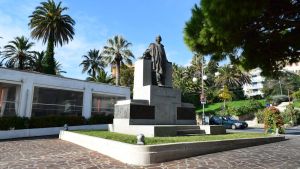 San Remo did not want to be outdone and already on 7 June the municipal council appointed a special commission, made up of twelve councillors, to promote a public subscription for the erection of a monument to Garibaldi in our city.
San Remo did not want to be outdone and already on 7 June the municipal council appointed a special commission, made up of twelve councillors, to promote a public subscription for the erection of a monument to Garibaldi in our city.
After a decade in which the matter was essentially dropped, on 5 January 1892 the new mayor Alessandro Escoffier appointed another commission for the monument composed of eleven members.
At the commission's second meeting on 15 March 1892, a number of engravings of monuments provided by the Sonzogno publishing house in Milan were examined.
In the meantime, various sketches were also examined, including one presented by the Genoese sculptor working in Rome Filippo Giulianotti, and three others that had been exhibited in the lobby of the Principe Amedeo Theatre, while the administration received printed matter and offers from Ettore Ximenes and Oldofredi in the same period.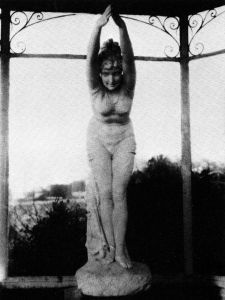 The municipal authorities, in search of a prestigious name, proposed that the monument be erected by the sculptor Odoardo Tabacchi, already known in the city
The municipal authorities, in search of a prestigious name, proposed that the monument be erected by the sculptor Odoardo Tabacchi, already known in the city 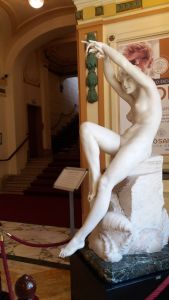 for having created the statue of Tuffolina and that of Cica-Cica, then located in the town hall in Piazza Nota.
for having created the statue of Tuffolina and that of Cica-Cica, then located in the town hall in Piazza Nota.
It was precisely this last work that prompted the municipal administration to ask Tabacchi, who, since only a maximum of eight thousand lire was available, was offered to take back his Cica-Cica as partial payment and to create the monument to the hero for the remaining amount.
In a letter sent by the Accademia Albertina in Turin on 21 May 1893, the sculptor declared his willingness to make the exchange on condition that he would not be competing with other sculptors. In fact, in the following years, other letters of proposal would reach the municipal administration, including two from the Lombard sculptor Giuseppe Cerini in 1894 and one from the Sanremo sculptor Filippo Ghersi in 1897.
Although another commission was appointed in 1897, consisting of the architect Pio Soli, Angelo Nota and Giacomo Drago, who declined the invitation, no decision was taken.
The Cica-Cica therefore remained the property of the municipal administration, while the task of creating the monument was entrusted in 1903 to Emilio Di Ciolo, a mediocre local sculptor, who was then teaching drawing and ornamental plastic figures at the San Remo Workers' Federation.
The artist offered the municipal administration the life-size sketch of the future monument free of charge, declaring that he would accept the sum of only 14,000 lire as compensation for the finished work, made of bronze and red granite from Baveno.
At first, the administration seemed to agree with Di Ciolo's requests, and he also involved Gusmano Vignali's Florentine artistic foundry in the estimates.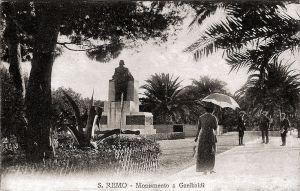 In 1904, it was decided to appoint a new commission to evaluate Di Ciolo's work. The sculptor Pietro Canonica, well known in the city, declined the invitation to join the commission, while Pio Soli, the Florentine sculptor Ezio Ceccarelli and the Turin painter Giacomo Grosso gave their consent. As the administration decided to get rid of the petulant local sculptor as soon as possible, the commission quickly rejected the project and proposed to reimburse Di Ciolo the sum of 1,000 lire for the sketch, even though it had initially been offered free of charge.
In 1904, it was decided to appoint a new commission to evaluate Di Ciolo's work. The sculptor Pietro Canonica, well known in the city, declined the invitation to join the commission, while Pio Soli, the Florentine sculptor Ezio Ceccarelli and the Turin painter Giacomo Grosso gave their consent. As the administration decided to get rid of the petulant local sculptor as soon as possible, the commission quickly rejected the project and proposed to reimburse Di Ciolo the sum of 1,000 lire for the sketch, even though it had initially been offered free of charge.
The Municipal Council eventually agreed to reimburse the Matuzian artist, but he would later lodge several complaints protesting the treatment he received.
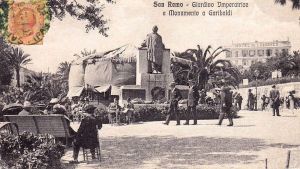
In the summer of 1905, at the suggestion of Giacomo Grosso, the Piedmontese sculptor Leonardo Bistolfi, one of the most famous and highly regarded artists of the time, was finally commissioned to carry out the work. He accepted the commission despite his numerous commitments, perhaps also to recover from his rejection in the competition for the Milanese monument of the same name won by Ximenes.
At the municipal council meeting of 9 August 1905, the relevant agreement, which had been agreed upon two weeks earlier with the sculptor from Casale Monferrato, was approved.
In view of the inauguration of the monument, which took several years to complete due to Bistolfi's other pressing commitments, At its meeting of 8 February 1908, the municipal administration decided to entrust the Tuscan painter Plinio Nomellini with the task of designing the inauguration poster, Galileo Chini was invited to produce the illustrated programme for the event, and the Genoese artist Edoardo De Albertis was commissioned to produce a metal plaque for the monument.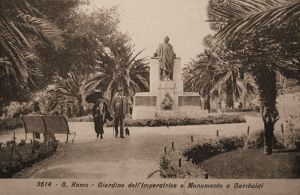 Gabriele D'Annunzio, who had been contacted on 20 February 1908 in Rome by the editor of «Caffaro» Mario Maria Martini, was also chosen to give the inaugural speech.
Gabriele D'Annunzio, who had been contacted on 20 February 1908 in Rome by the editor of «Caffaro» Mario Maria Martini, was also chosen to give the inaugural speech.
However, the poet declined the invitation and so the administration decided to send three telegrams to Giovanni Pascoli inviting him to give one of the inaugural speeches.
Pascoli decided to accept the invitation, so much so that his name appeared in all the printed programmes and in Nomellini's poster, but he was unable to attend the event as he was forced to undergo a delicate operation in the very days in which he should have been in San Remo to give the official speech in front of the new monument.
At 8.30 p.m. on 25 April 1908 the celebrations for the inauguration of the monument, which was placed in an open space in the gardens of the Imperatrice promenade, opened with a speech by the man of letters and poet Giovanni Marradi, while the following morning the official speeches were made by the monument's author Leonardo Bistolfi, the socialist mayor of Sanremo Orazio Raimondo and the journalist and editor of the «Corriere della Sera» Giovanni Borelli.
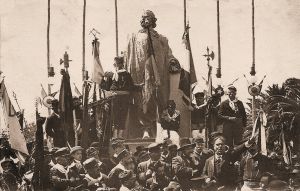 Corriere della Sera of 27 April wrote: « ... ... at 11.00 a.m. the procession assembles in Piazza Colombo. A squad of carabinieri in full dress opened the parade; they were followed by Garibaldi's soldiers and veterans of their country's battles, the flags of the municipalities of Sanremo and Porto Maurizio, the town council of Sanremo, representatives of numerous Italian and French municipalities, almost all the societies, chambers of work and Ligurian socialist circles, a large number of Masonic lodges, especially French, and schools. A forest of flags appeared before the spectator's eyes: more than 200. The procession parades in an orderly fashion, to the sound of Garibaldi's hymn, through Via Vittorio Emanuele and Corso dell'Imperatrice, lined with flags and crowded with spectators who, following the procession, trample on the splendid flowerbeds around the monument, having found the free space occupied by more hurried spectators. The order service is extremely tiring, but there are no incidents to report. It is 11.40 a.m. The flags are barely gathered around the monument: the Garibaldians stand at attention, the trumpet blows, the cloth falls. The music sings the fateful hymn. The moment is solemn. The admiration of the crowd can be heard in the deep silence, which is immediately broken by roaring applause. Hats are waved from the grandstands, from the trees, from the ancient pines, which seem to bear clusters of fruit. Cheers are raised... ».
Corriere della Sera of 27 April wrote: « ... ... at 11.00 a.m. the procession assembles in Piazza Colombo. A squad of carabinieri in full dress opened the parade; they were followed by Garibaldi's soldiers and veterans of their country's battles, the flags of the municipalities of Sanremo and Porto Maurizio, the town council of Sanremo, representatives of numerous Italian and French municipalities, almost all the societies, chambers of work and Ligurian socialist circles, a large number of Masonic lodges, especially French, and schools. A forest of flags appeared before the spectator's eyes: more than 200. The procession parades in an orderly fashion, to the sound of Garibaldi's hymn, through Via Vittorio Emanuele and Corso dell'Imperatrice, lined with flags and crowded with spectators who, following the procession, trample on the splendid flowerbeds around the monument, having found the free space occupied by more hurried spectators. The order service is extremely tiring, but there are no incidents to report. It is 11.40 a.m. The flags are barely gathered around the monument: the Garibaldians stand at attention, the trumpet blows, the cloth falls. The music sings the fateful hymn. The moment is solemn. The admiration of the crowd can be heard in the deep silence, which is immediately broken by roaring applause. Hats are waved from the grandstands, from the trees, from the ancient pines, which seem to bear clusters of fruit. Cheers are raised... ».
On 27 April, the poet Angiolo Silvio Novaro gave another speech in front of the town's schoolchildren, who had marched past the monument, whose inauguration was also attended by important writers and painters who at the time worked on the literary periodical «La Riviera Ligure» owned by the Novaro family, linked to the most authoritative exponents of the Italian decadent movement.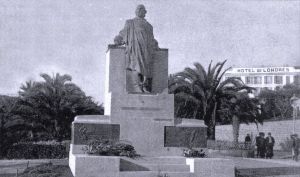 In the monument, Bistolfi wanted to depict the Hero of the Two Worlds, at a ripe old age, standing, looking towards his Caprera, leaning against and enveloped by the granite base, in a pensive attitude, his hair waving in the wind and his poncho wrapping his figure in noble and majestic tones.
In the monument, Bistolfi wanted to depict the Hero of the Two Worlds, at a ripe old age, standing, looking towards his Caprera, leaning against and enveloped by the granite base, in a pensive attitude, his hair waving in the wind and his poncho wrapping his figure in noble and majestic tones.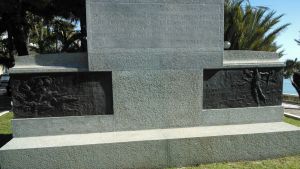 At his feet are six bronze bas-reliefs depicting as many illustrative moments in Garibaldi's life: the island of Caprera, symbolised by a maiden in the waves (Elegy of Solitude); a wave that turns into two figures embracing (Love Song); a group of maidens portrayed while dancing (Voices of Joy); a male figure with a female one surrounded by seas and mountains (Cry of Freedom); some men running enthusiastically launched across the sea (The Hymn of the Thousand); triumph of a deceased warrior (The Hero).
At his feet are six bronze bas-reliefs depicting as many illustrative moments in Garibaldi's life: the island of Caprera, symbolised by a maiden in the waves (Elegy of Solitude); a wave that turns into two figures embracing (Love Song); a group of maidens portrayed while dancing (Voices of Joy); a male figure with a female one surrounded by seas and mountains (Cry of Freedom); some men running enthusiastically launched across the sea (The Hymn of the Thousand); triumph of a deceased warrior (The Hero).
Bistolfi's work thus greatly influenced a number of sculptors working in the city, including Jules Van Biesbroeck, who took up some of the Piedmontese sculptor's characteristic motifs in the tomb of Catherine Coudlougon, where Bistolfi's influence can be seen above all in the subtle flashes of light that emerge in the bronze volume of the monument.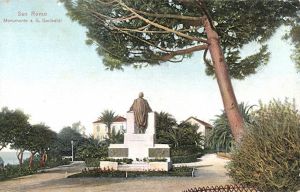 During the Second World War, some people suggested casting the monument in order to obtain metal for cannons (a fate that had befallen Vincenzo Pasquali's statue above the war memorial in Corso Mombello in 1942) but fortunately the proposal was not followed up, thanks also to the intervention of a
During the Second World War, some people suggested casting the monument in order to obtain metal for cannons (a fate that had befallen Vincenzo Pasquali's statue above the war memorial in Corso Mombello in 1942) but fortunately the proposal was not followed up, thanks also to the intervention of a 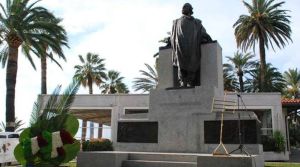 group of courageous citizens led by the San Remo painter Carlo Alberto, who had the monument hidden in a depot in Via Ruffini until the end of the war.
group of courageous citizens led by the San Remo painter Carlo Alberto, who had the monument hidden in a depot in Via Ruffini until the end of the war.
Recently, following a gradual deterioration of the monument, a careful and accurate restoration of both the statue of the Hero and its base has been carried out, restoring its original splendour and shine.
(source: taken from an article by Andrea Gandolfo on "Riviera24.it" of 10/01/2018; images from the web and private archives)




